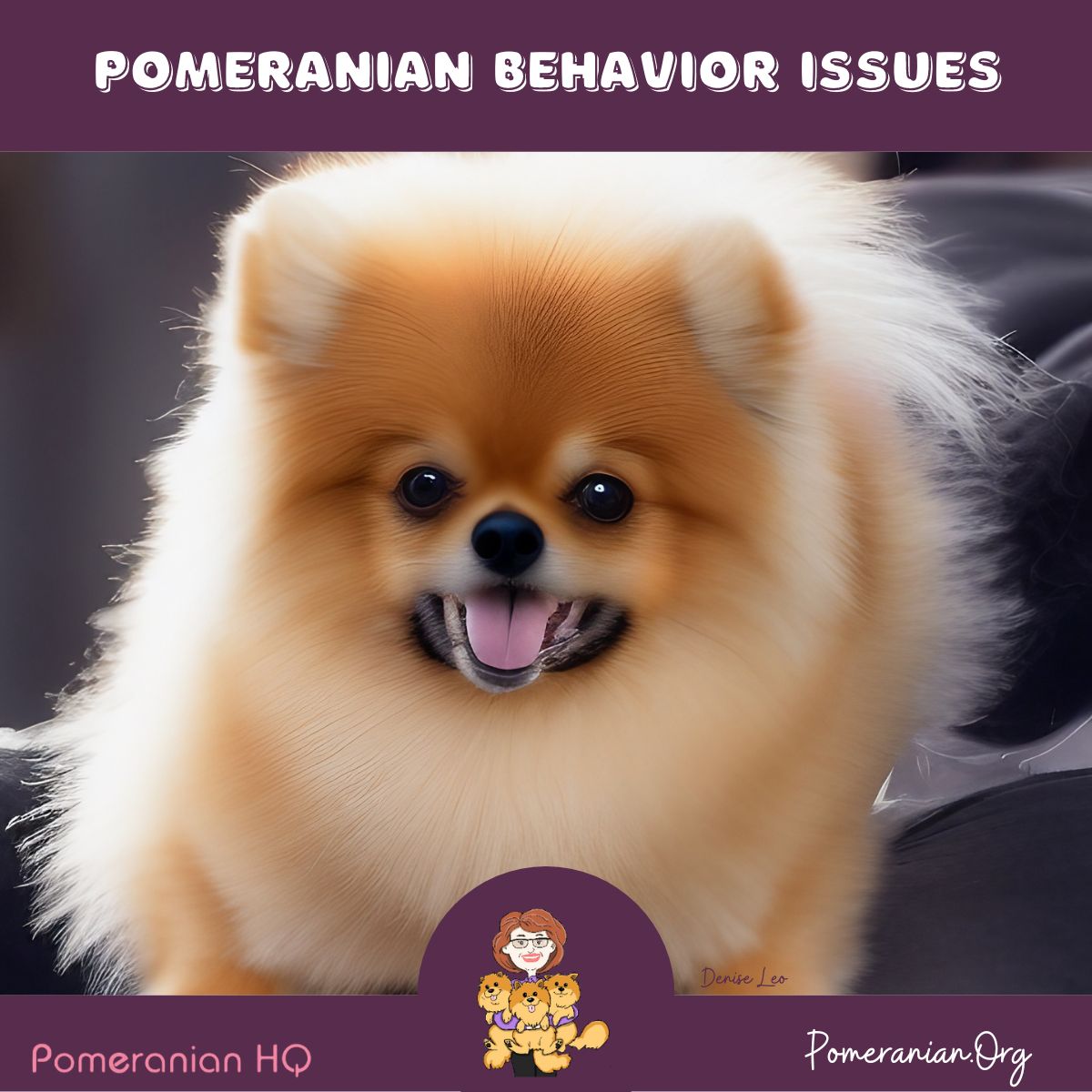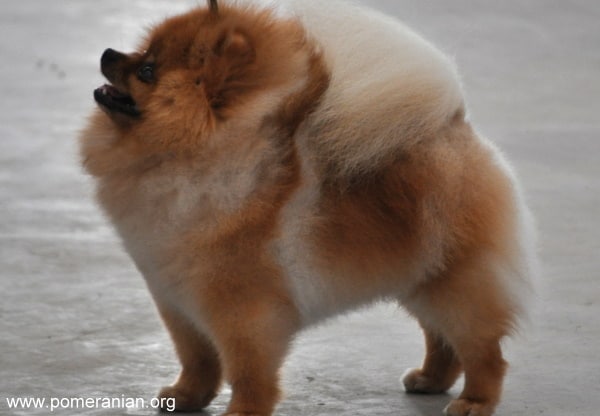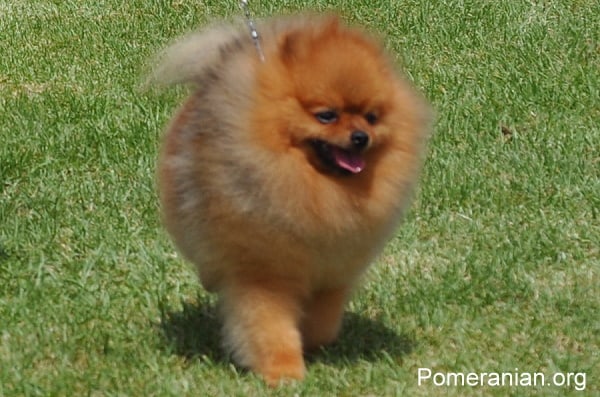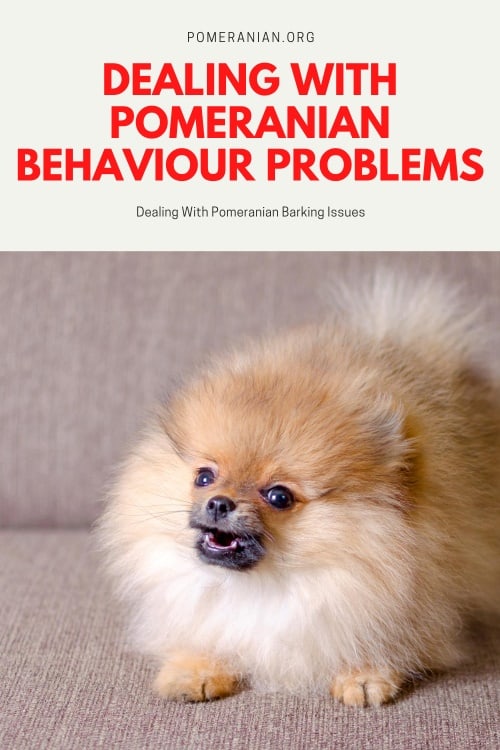Last Updated on 25/04/2024 by Dochlaggie. Post first published on January 22, 2023.
Are you a proud Pomeranian owner looking for strategies to tackle problem behaviors? If so, then this article is for you. We’ll cover the five most common behavior issues that Pomeranians face and discuss solutions to each issue based on established best practices and scientific research.
We’ll also touch on key topics like proper training methods and supplementing diet – all while keeping in mind your beloved Pom’s individual needs! By the end of your reading journey, you’ll be more than equipped with the tools to help shape any pesky Pom behaviors.
Living with a Pomeranian can be an enriching experience; however, they also come with unique personality quirks that need to be considered. Not every Pom behaves the same way, and it’s essential to address behavioral issues if your pup is exhibiting them.
Pomeranian Behavior Issues Facts
- Pomeranian dogs and most toy breed dogs can display territorial aggression, barking at visitors and other animals. Training them not to bark is essential for a peaceful lifestyle.
- Pomeranians may also beg for food; the best way to stop this behavior is by only providing treats during scheduled meal times and never rewarding begging with food or attention.
- Guarding their food can be another issue that needs addressing; owners should feed smaller serves, give treats as part of meals, feed one piece of kibble at a time and never remove the bowl unless they plan on giving something better in return.
- Successfully tackling Pomeranian behavioral issues requires patience, consistency, and lots of love – positive reinforcements such as praises will help shape desirable behaviors over time!

Pomeranian Dogs Often Possess Territorial Aggression
Having a small dog breed that tries to defend you is great, but many Pomeranians take this responsibility more seriously than others. They’ll bark at visitors, neighbors in their yards, and anybody walking past your home.
They may also view your car as something to protect. Poms may try to defend you from other dogs too.
There are some elements of this territorial Pomeranian behavior that you can teach your Pomeranian. For example, if the postman enters your yard or stops at your letterbox, your Pom may bark and keep at it until the postman is gone. Then your dog is happy because he believes he successfully got rid of the stranger. Your Pom dog now thinks he is a Pomeranian guard dog.
Eventually, your Pom may believe he’s the toughest dog on the block. The general behavior is that a dog will bark whenever a stranger enters their territory but as soon as you tell him to be quiet, he does so.
However, you can’t always make him stop barking, and some owners think it’s fantastic that he’s such a fearless watchdog. A Pomeranian dog who tries to protect you too much can quickly become a pest and a danger in that you could fall over him while walking or trying to stop him from barking. This is the case with dogs of any size.
Dealing With Pomeranian Barking Issues
Here are some tips to help you stop Pomeranian barking:
- Stop him from behaving territorially by moving him away from 1. Your fenced yard if you know somebody will go past your home. 2. Your front door if visitors are expected. 3. Seeing the mailbox when the postman arrives.
- Give him treats if he behaves by sitting and not barking when people visit.
- Ask visitors to bring treats. It’s common for dog owners to increase their Pomeranian’s aggressive tendencies by distracting or reassuring him because he views it as a reward for such aggressive behavior. Don’t yell at him because he wrongly believes you’re simply joining in.
Training a Pomeranian Not to Beg
Your dog will beg for food more often than you would like, and you can’t give in all the time. Otherwise, he’ll keep doing it because he’ll understand that if he does that, he gets rewarded. His pleading puppy dog eyes are almost irresistible, and you may even give him small pieces of your meal. He can make you feel guilty whenever you eat a mouthful of food.

Pomeranian puppy behavior is quickly learned. A dog learns actions that benefit him. If he barks while you eat and give him a treat, he’ll associate that action with food and keep at it until you stop him from doing it.
If you refuse to give him food, except for his scheduled meal time, he’ll soon stop barking because he’ll know it doesn’t help him. If you relent and give him treats while dining, even only once in a while, it weakens your resolve and tells him to bark more and more.
Here’s a good example. If you insert a coin into a soft drink machine, you expect a drink to come out. If the machine refuses to give you a drink after inserting the coins, you’ll be unhappy but may try again. If you still can’t get what you want, you’ll likely give up and assume it’s faulty.
Now think about a slot machine. You feed it coins and more coins, hoping to hit the jackpot with the next coin, but usually, you don’t.
If you do reward your dog sometimes if he begs, you’ll become a slot machine, and he will become addicted to gambling. Be the soft drink machine and use the all-or-nothing method.

How to Reduce Your Pomeranian Dog’s Reaction to Guarding Food
Some dog owners have very strange thoughts One that’s more sad than strange is to train your dog to let you take his food away…by actually taking it away. Your pet likes to eat in peace, but if you keep taking it away, he’ll growl to warn you and tell you he doesn’t like that. So you have an “aha! moment.”
Then you’ll punish your Pomeranian. So he’s already annoyed but takes another bite. If you still think you can’t trust him, you’ll punish him more until he stops eating.
Even though your pet lets you keep doing this testing, you may have a child visiting one day, and she might pick up your Pom’s bowl, so he bites her. He’s then described as vicious, and the next step is the pound.
No Pomeranian owner wants their dog to be food-guarding, but some owners refuse to stop this childish behavior. On the other hand, you want to train him, so he understands that your hands will give him food, not remove his bowl.
There are four ways to do this:
- Feed him smaller serves, wait until that’s finished, and then put treats in his bowl.
- Give him treats as part of his meal, to begin with.
- •Feed him with kibble, one piece at a time, dropping the next into his bowl while he eats the one already there.
- Never remove food unless you plan to give him a better food.
- Eventually, he’ll beg you to come close to the bowl. If you have multiple dogs, each one may guard their bowl and treats from the others. You need to feed each dog separately and give treats alone in a room or in individual crates. Never drop a treat between two dogs; they’ll fight over it, or one will swallow it so fast he chokes on it.
Don’t let treats be left somewhere because later discovery can cause trouble, perhaps when you’re not even home.
Pomeranian Behavior Issues Conclusion
As a pet parent of a Pomeranian, it’s essential to prioritize the behaviors you want them to display. They’re intelligent and relatively easy to train. Give your Pomeranian lots of love and patience, praising good behavior and rewarding with appropriate treats. Remember, consistency is vital.
If you are patient and consistent, your Pomeranian will be able to learn how you expect them to act in social situations. With adequate training, discipline, exercise, and affection, you can help your Pomeranian overcome any behavioral issues.
Teaching them desirable behaviors takes time, so don’t get frustrated if they don’t respond quickly. A puppy socialization class is a wonderful idea. Please work with your pup; soon enough, all the hard work will pay off when their positive behaviors begin to show!
Copyright Pomeranian.Org. All Rights Reserved.
References and Further Reading:
[1] Official Standard of the Pomeranian (AKC). American Kennel Club, 2011.
[2] Official English Kennel Club Pomeranian Breed Standard, 2017.
[3] Kimbering Pomeranians “1891-1991”.
[4] Denise Leo, The Pomeranian Handbook.
[5] E.Parker, The Popular Pomeranian.
[6] L.Ives, Show Pomeranians.
Purchase the Pomeranian Handbook by Denise Leo









